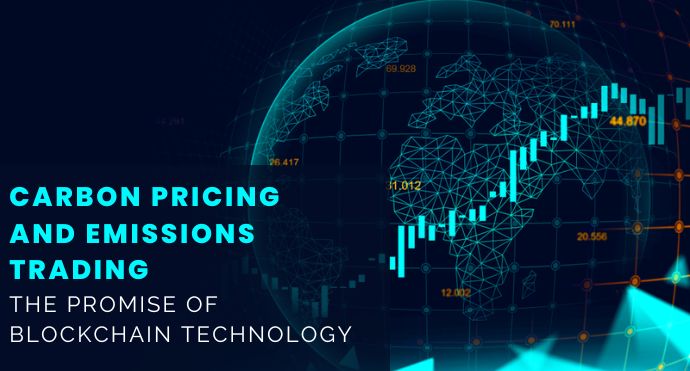In a world yearning for effective solutions to combat climate change, blockchain technology emerges as a transformative force. With its decentralized and transparent nature, it promises to revolutionize carbon pricing and emissions trading. Imagine a future where fraud is eradicated, transparency reigns supreme, and every carbon credit and emissions transaction is recorded immutably on a distributed ledger. Through enhanced traceability and automation, blockchain ensures the accuracy and reliability of carbon credits, while tokenization enables seamless trading and global participation. This harmonious collaboration, powered by blockchain, holds the key to a greener, more sustainable world, uniting nations and organizations in a collective endeavor to shape a future where environmental responsibility and technological prowess intertwine for the betterment of our planet.
Understanding Carbon Pricing
Carbon pricing is a critical policy tool used to internalize the environmental costs of carbon emissions. It puts a price on fossil fuel usage based on the amount of carbon dioxide emitted, which helps to reduce greenhouse gas emissions and promote a shift to renewable energy sources.
Carbon pricing works through two primary methods: carbon tax and emissions trading. A carbon tax imposes a fixed price per ton of carbon emitted, while emissions trading creates a market for companies to buy and sell carbon credits. This market incentivizes the reduction of carbon emissions by allowing companies to sell unused credits or buy credits from others to meet their own emissions targets. The economic impact of carbon pricing depends on the specific policies and the way they are implemented. Carbon taxes can create new revenue streams for governments, while emissions trading can reduce compliance costs for companies. However, there are also potential drawbacks, such as price volatility and the possibility of carbon leakage, where emissions are simply moved to other jurisdictions rather than reduced overall.
Understanding Emissions Trading:
What is Emissions Trading? It’s a market-based approach to controlling pollution. Companies get a certain amount of emissions allowances, and they can trade these allowances on the market. If a company pollutes more, they have to buy more allowances. If a company pollutes less, they can sell their extra allowances. This incentivizes companies to reduce their emissions.
How Emissions Trading Works?
The government determines the overall emissions cap and then divides it into allowances. These allowances can be traded on an exchange. Companies that exceed their emissions cap are required to purchase additional allowances, while companies with surplus allowances can sell them. Issues with Current Emissions Trading Systems? One of the biggest issues with current emissions trading systems is their lack of transparency. It’s difficult to verify emissions data, and there’s no way to track each allowance’s ownership history. This makes it easy for companies to commit fraud, either by misreporting their emissions or by selling fake allowances. But fear not, as Blockchain technology can potentially eliminate these issues with current emissions trading systems. Stay tuned for the next section to find out how!
What is Blockchain Technology?
Blockchain technology is a decentralized digital ledger that enables secure and transparent transactions. It is a revolutionary technology that has the potential to disrupt various industries. Blockchain provides a secure, tamper-resistant and distributed database that can be used to store and manage data without the need for a central authority or a middleman. The technology works by creating a network of nodes that validate each transaction in the database. Each transaction is verified by multiple nodes in the network, and once a consensus is reached, the transaction is added to the ledger. This ensures that the data is secure, transparent and tamper-proof.
One of the key advantages of blockchain technology is that it provides transparency and security. Since every transaction is recorded on a distributed ledger, it is virtually impossible to manipulate or hack the data. Additionally, blockchain provides a high level of data privacy and security, as each user has a unique private key to access their data. Overall, blockchain technology has the potential to revolutionize various industries and disrupt traditional business models. In the context of carbon pricing and emissions trading, blockchain technology can help decentralize the marketplace, reduce costs and fraud, and enhance transparency and accountability.
How can Blockchain Technology help Carbon Pricing and Emissions Trading?
One of the main advantages of using Blockchain technology in carbon pricing and emissions trading is that it provides a decentralized marketplace. This helps to avoid dependence on a central authority, such as a government or a corporation. Additionally, it can reduce costs and fraud by automating key tasks such as tracking carbon credits and the creation of smart contracts. Ultimately, blockchain technology helps to enhance transparency and accountability in carbon pricing and emissions trading.
Real World Examples: The potential of Blockchain technology in carbon pricing and emissions trading has inspired various projects like CarbonX, ClimateCoin, and ImpactPPA that are exploring innovative solutions using blockchain. CarbonX is a blockchain platform designed to incentivize individuals and businesses to reduce their carbon footprint. ClimateCoin offers a peer-to-peer trading market for carbon credits, while ImpactPPA is using blockchain to streamline the carbon credit trading process for renewable energy projects. These platforms are showing us how blockchain can transform the sustainability and carbon trading industry.
Conclusion:
Blockchain technology has the potential to revolutionize both carbon pricing and emissions trading by enhancing transparency, reducing costs and fraud, and decentralizing the marketplace. Real-world examples such as CarbonX, ClimateCoin, and ImpactPPA demonstrate that blockchain can already play a significant role in solving the challenges of carbon pricing and emissions trading. In the future, we can expect to see more innovation and progress in this area as the world becomes increasingly aware of the urgent need to address climate change.



